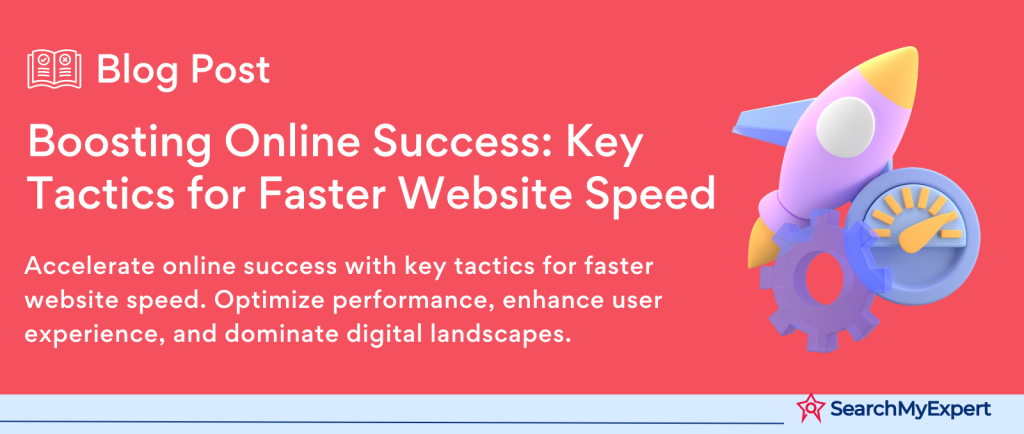The Importance of Website Speed
The Critical Role of Website Speed in the Digital Age
In today’s fast-paced digital landscape, website speed is no longer a luxury; it’s a necessity. At its core, website speed refers to how quickly a webpage loads its content, including text, images, and videos. This speed is a crucial factor in defining the user experience, search engine rankings, and overall success of a website.
Why Does Website Speed Matter?
- First Impressions Count:
The initial moments a visitor spends on your site are pivotal. Slow-loading pages can frustrate users, leading them to abandon the site even before it fully loads. - Search Engine Rankings: Search engines, like Google, prioritize faster websites in their search results. A quicker website is seen as more user-friendly, boosting its ranking.
- Enhanced User Experience: A speedy website provides a smooth and enjoyable browsing experience, encouraging users to stay longer and explore more.
- Conversion Rates: Website speed directly impacts conversion rates. Faster sites are more likely to convert visitors into customers or subscribers.
- Mobile User Optimization:
With the increasing number of mobile internet users, website speed becomes even more crucial. Mobile users often rely on less stable internet connections, making website speed a determining factor in accessibility.
The Downside of Slow-Loading Websites
- Increased Bounce Rates:
Slow websites lead to higher bounce rates as visitors lose patience and leave. - Negative Brand Perception: A sluggish site can harm your brand’s reputation, making it appear outdated or unreliable.
- Loss of Revenue:
For e-commerce sites, every extra second of loading time can result in significant losses in sales. - SEO Penalties:
Search engines might penalize slow-loading sites, pushing them down in search rankings.
Decoding the Impact of Loading Times on User Engagement and Satisfaction
Slow loading times are more than just a minor inconvenience; they can significantly impact user engagement, conversion rates, and overall satisfaction. This section delves into the tangible effects of sluggish websites on user behavior, supported by research and statistics, and explores the broader implications for brand perception and loyalty.
Understanding User Behavior and Website Speed
Diminished User Engagement:
- Slow websites often lead to a drop in user engagement. Users are less likely to interact with the site, resulting in reduced page views, lower time spent on the site, and limited interaction with content or features.
- Statistical Insight:
According to a study by Akamai, a 100-millisecond delay in website load time can decrease customer engagement by 7%.
Lower Conversion Rates:
- Conversion rates, a critical measure of a website’s success, are directly impacted by loading times. Users are less likely to complete purchases or sign-ups on a slow website.
- Relevant Data:
A study by Portent found that websites loading in one second have a conversion rate 3 times higher than those loading in five seconds.
User Satisfaction and Experience:
- Slow websites create a frustrating user experience. This dissatisfaction can lead to a negative overall impression of the brand.
- Research Insight:
According to Google, the probability of bounce increases dramatically as page load time goes from one to five seconds.
The Broader Implications for Brands
Brand Perception:
- Slow loading times can tarnish a brand’s image. Users often equate the performance of a website with the quality of the products or services offered.
- Brand Image Impact:
A sluggish website can make a brand appear technologically backward or indifferent to customer experience.
Customer Loyalty:
- User loyalty is at stake with slow websites. Frustrated users are less likely to return, impacting repeat business and long-term customer relationships.
- Loyalty Statistics: A study by the Aberdeen Group noted that a one-second delay in page load time can lead to a 7% reduction in customer conversions, hinting at a decline in loyalty.
Word-of-Mouth and Social Sharing:
- Users are less likely to recommend or share links from slow-loading websites, impacting potential word-of-mouth marketing.
- Social Sharing Impact: Slow websites can see a reduction in social media sharing, limiting their reach and potential new customer acquisition.
Maximizing SEO Performance Through Website Speed Optimization
Website speed is a critical component in the realm of Search Engine Optimization (SEO). It’s not just about the user experience; it’s also about how search engines, particularly Google, evaluate and rank your website. This section explores the connection between website speed, Google’s Core Web Vitals, and search engine algorithms, and provides strategies for optimizing your website’s speed to boost SEO performance.
Website Speed and SEO Rankings
Speed as a Ranking Factor:
- Search engines prioritize user experience, and website speed is a key component. Fast-loading websites are likely to rank higher in search engine results pages (SERPs).
- Google’s Emphasis on Speed:
In 2010, Google announced that site speed would be included as a new signal in its search ranking algorithms.
Mobile-First Indexing:
- With the increasing predominance of mobile browsing, Google’s mobile-first indexing requires websites to be optimized for speed on mobile devices.
- Mobile Speed Significance:
A slow mobile site can negatively impact your SEO rankings, as most searches now occur on mobile devices.
Impact of Core Web Vitals on SEO
Introduction to Core Web Vitals:
- Launched by Google, Core Web Vitals are a set of specific factors that Google considers important in a webpage’s overall user experience.
- Components of Core Web Vitals: They include Largest Contentful Paint (LCP), First Input Delay (FID), and Cumulative Layout Shift (CLS), all of which are influenced by website speed.
Largest Contentful Paint (LCP):
- LCP measures loading performance. To provide a good user experience, LCP should occur within 2.5 seconds of when a page first starts loading.
First Input Delay (FID):
- FID measures interactivity. Pages should have an FID of less than 100 milliseconds for a good user experience.
Cumulative Layout Shift (CLS):
- CLS measures visual stability. Pages should maintain a CLS of less than 0.1.
Strategies for Optimizing Website Speed for SEO
- Optimize Images:
Use image formats like WebP which provide high quality at smaller file sizes. Implement responsive images and lazy loading to further improve loading times. - Leverage Browser Caching:
Browser caching stores webpage resource files on a local computer when a user visits a webpage, which helps in loading the page faster on subsequent visits. - Minimize HTTP Requests:
Reduce the number of elements on your page to minimize the number of HTTP requests required for rendering the page. - Use Content Delivery Networks (CDNs):
CDNs distribute your content across multiple, geographically diverse servers to minimize the distance between the server and the user, enhancing loading speed. - Optimize CSS and JavaScript:
Minify and combine files where possible. Also, use asynchronous loading for JavaScript files to improve page load time. - Improve Server Response Time:
Optimize your server, use quality web hosting, and consider using a dedicated server if needed to improve response times. - Implement AMP (Accelerated Mobile Pages):
Use AMP to build lightweight pages that load quickly on mobile devices.
The Financial Imperative of Optimizing Website Speed for Revenue and Conversions
In the digital marketplace, the speed of your website is not just a technical metric; it’s a critical business factor directly linked to sales, revenue, and conversions. This section sheds light on how enhanced website speed can significantly uplift a business’s financial performance, supported by compelling data and statistics.
Direct Link Between Website Speed and Sales
Increased Revenue:
- Faster websites lead to higher user retention and engagement, and consequently, increased revenue opportunities.
- Statistical Evidence:
A study by Amazon found that every 100ms of improvement in their site speed resulted in a 1% increase in revenue.
Improved Conversion Rates:
- Website speed directly impacts conversion rates. Faster load times lead to more completed purchases or sign-ups.
- Conversion Data: According to a report by Portent, websites with a load time of 1 second enjoy a conversion rate of 2.5 times higher than those with a 5-second load time.
Financial Benefits of Faster Loading Times
Reduced Bounce Rates:
- Faster websites have lower bounce rates, ensuring that more visitors stay and potentially convert.
- Bounce Rate Statistics: Google’s research indicates that as page load time goes from 1 to 3 seconds, the probability of bounce increases by 32%.
Higher Average Order Value:
- Customers are more likely to browse more products and spend more on a fast-loading website.
- Average Order Value:
A study by Akamai revealed that a 100-millisecond delay in website load time can decrease conversion rates by 7%.
Increased Customer Lifetime Value:
- Speedy websites foster customer loyalty, leading to repeat business and higher customer lifetime value.
- Long-Term Customer Value:
Faster websites create a positive user experience, encouraging repeat visits and long-term customer relationships.
The Role of Website Speed in Customer Satisfaction and Retention
Enhanced User Experience:
- A fast website creates a seamless and enjoyable browsing experience, increasing customer satisfaction.
- User Experience Impact: A better user experience on a fast-loading website can lead to higher customer satisfaction and loyalty.
Improved Brand Perception:
- The speed of your website reflects on your brand. A fast website is often seen as more professional and reliable.
- Brand Perception:
Users often correlate the efficiency of a website with the quality of services or products offered.
Competitive Advantage:
- In a market where milliseconds can make a difference, having a faster website than competitors can give a significant edge.
- Market Differentiation:
Businesses with faster websites can stand out in the crowded online space, attracting more customers.
Navigating Technical Factors to Enhance Website Speed and Performance
Website speed can be influenced by a myriad of technical factors, ranging from the size of your image files to the efficiency of your coding and server performance. Understanding and addressing these factors is essential for optimizing your website’s speed. This section identifies common technical hindrances and offers insights into how they can be effectively managed.
Key Technical Factors Affecting Website Speed
Large Image and Media Files:
- High-resolution images and videos can significantly slow down page loading times.
- Solution: Optimize images and videos by compressing them and using appropriate formats like WebP for images and MP4 for videos. Implement lazy loading for media content.
Inefficient Coding:
- Bulky code with unnecessary characters, comments, and unoptimized CSS and JavaScript can hinder website performance.
- Solution: Minify CSS, JavaScript, and HTML to reduce file size. Use CSS sprites to reduce HTTP requests.
Poor Server Performance:
- Server response time can dramatically affect website speed, influenced by factors like web hosting quality and server location.
- Solution:
Choose a reliable hosting provider. Consider upgrading to a dedicated server or a CDN (Content Delivery Network) for better performance.
Excessive HTTP Requests:
- Each piece of your website (images, scripts, CSS files) requires an HTTP request to load, more requests mean slower load times.
- Solution:
Combine files where possible, use CSS instead of images where applicable, and streamline the number of elements on your page.
Unoptimized Browser Caching:
- Failing to leverage browser caching means users have to download website resources every time they visit.
- Solution: Set up proper caching guidelines so browsers can store these resources for repeated visits.
Non-Responsive Design:
- Websites that are not optimized for various devices and screen sizes can experience slow loading times on mobile devices.
- Solution: Implement responsive design to ensure efficient loading across devices.
Too Many Ads or Pop-ups:
- Excessive advertisements or pop-ups can slow down your website and create a negative user experience.
- Solution:
Limit the number of ads and optimize their size and placement.
Tools and Techniques for Optimizing Website Speed
- Google PageSpeed Insights:
A tool that provides insights into your website’s performance and offers specific recommendations for improvement. - GTmetrix:
Analyzes the loading speed of your website and provides actionable recommendations to optimize performance. - YSlow:
A browser extension that analyzes web pages and explains why they’re slow based on Yahoo!’s rules for high-performance websites. - WebPageTest:
Allows you to test your site’s performance from different locations and browsers, providing detailed optimization suggestions. - Compression Tools:
Use tools like Gzip to compress your website’s resources, reducing the size of files transferred between server and browser. - CDN Services:
Implement a CDN to distribute your content globally and reduce the latency by serving resources from a server closest to the user.
By addressing these technical factors and utilizing the appropriate tools and techniques, you can significantly improve your website’s speed and performance. This enhancement not only provides a better user experience but also positively impacts your SEO and overall online presence. Next, we will delve into how to effectively measure and analyze website speed to identify areas for improvement.
Implementing Effective Strategies to Boost Website Speed
Implementing Effective Strategies to Boost Website Speed
Enhancing website speed is essential for a better user experience, improved SEO, and increased conversions. This section outlines practical and actionable strategies to optimize your website’s speed, along with resources and tools to assist in implementing these improvements.
Optimizing Images and Media Files
Strategy:
Compress and resize images, use modern formats like WebP, and implement lazy loading for media.
Tools/Resources:
- Image Compression Tools:
Services like TinyPNG or ImageOptim can significantly reduce image file sizes without compromising quality. - Lazy Loading:
Utilize JavaScript libraries like Lozad.js for implementing lazy loading, which loads images and videos only as they are about to enter the viewport.
Implementing Caching Mechanisms
Strategy:
Use browser and server-side caching to store frequently accessed resources, reducing load times on subsequent visits.
Tools/Resources:
- Caching Plugins: For platforms like WordPress, plugins like W3 Total Cache or WP Super Cache can easily manage caching.
- Web Host Settings:
Consult your hosting provider’s documentation to optimize server-side caching.
Minimizing Redirects
Strategy:
Reduce the number of redirects to decrease load time. Each redirect triggers an additional HTTP request, slowing down the user experience.
Tools/Resources:
- Redirect Audit Tools:
Use tools like Screaming Frog SEO Spider to identify and minimize unnecessary redirects.
Utilizing Content Delivery Networks (CDNs)
Strategy: Distribute your content across multiple, geographically diverse servers to reduce the distance between users and server resources.
Tools/Resources:
- DN Providers: Services like Cloudflare, Akamai, or Amazon CloudFront can effectively distribute your content globally.
Optimizing Code and Scripts
Strategy: Minimize and combine CSS and JavaScript files, and defer the loading of non-critical JavaScript.
Tools/Resources:
- Minification Tools: Use tools like UglifyJS for JavaScript and CSSNano for CSS to minify code files.
- Asynchronous Loading: Apply async or defer attributes to script tags to optimize the loading of JavaScript files.
Choosing a Reliable Hosting Provider
Strategy: Select a hosting provider known for excellent uptime and fast server response times.
Tools/Resources:
- Web Hosting Reviews:
Research and compare hosting providers using review sites like Trustpilot or G2. - Speed Test Tools: Tools like Pingdom or GTmetrix can test server response time.
Prioritizing Website Speed: The Key to Unlocking Digital Success
the speed of your website is a cornerstone of digital success, impacting every aspect from user experience to revenue generation. This comprehensive guide has underscored the multifaceted importance of website speed and offered actionable strategies to enhance it.
Recap: The Far-Reaching Impact of Website Speed
- User Experience:
Fast-loading websites offer a seamless, enjoyable browsing experience, significantly reducing bounce rates and increasing user engagement. - SEO Advantages:
Speed is a critical factor in SEO rankings. Optimized websites stand a better chance of ranking higher in search engine results, attracting more organic traffic. - Boosting Revenue and Conversions: There is a direct correlation between website speed and financial performance. Faster websites tend to have higher conversion rates and increased sales.
- Brand Perception: The speed of your website influences how users perceive your brand. Quick, efficient sites are associated with professionalism and reliability.
- Competitive Edge: In the competitive online marketplace, website speed can be a decisive factor that sets you apart from the competition.
Actionable Call to Action
- For Website Owners:
It’s time to turn attention to your website’s speed. It’s not just an IT concern but a crucial business strategy. Audit your website, identify areas for improvement, and implement the strategies discussed. - For Developers:
Continue to innovate and optimize. Embrace the latest techniques in coding, caching, and content delivery to build lightning-fast websites that stand the test of time and technology. - For All: Remember, website speed optimization is an ongoing process. Regular monitoring and updating are essential to keep pace with technological advancements and evolving user expectations.
Your Next Steps
- Conduct a Speed Test:
Use tools like Google PageSpeed Insights or GTmetrix to evaluate your current website speed. - Implement Key Strategies: Start with the low-hanging fruit – optimize images, enable caching, and minimize HTTP requests.
- Seek Expert Advice: If needed, consult with digital marketing or web development professionals to guide you through more complex optimizations.
- Monitor and Iterate: Regularly review your website’s performance and make adjustments as needed. The digital landscape is ever-evolving, and so should your website.
Conclusion:
In the digital era, website speed is not just a technical metric but a vital component of online success. It profoundly influences user experience, SEO rankings, revenue, and brand reputation. As we have explored, simple yet effective strategies like optimizing images, leveraging caching, and choosing the right hosting provider can make a significant difference. By prioritizing and continuously improving website speed, businesses and developers can ensure they not only meet but exceed the evolving demands of the digital landscape. Take the step today towards optimizing your website’s speed and unlock the full potential of your online presence.
Partner with the best in digital design – Web Design Agencies.
Table of Contents
Toggle






